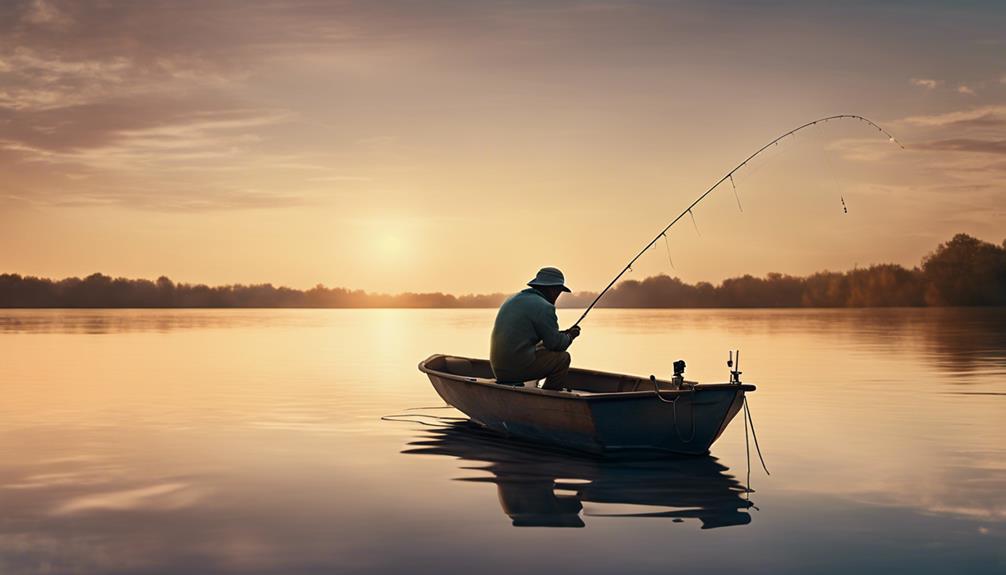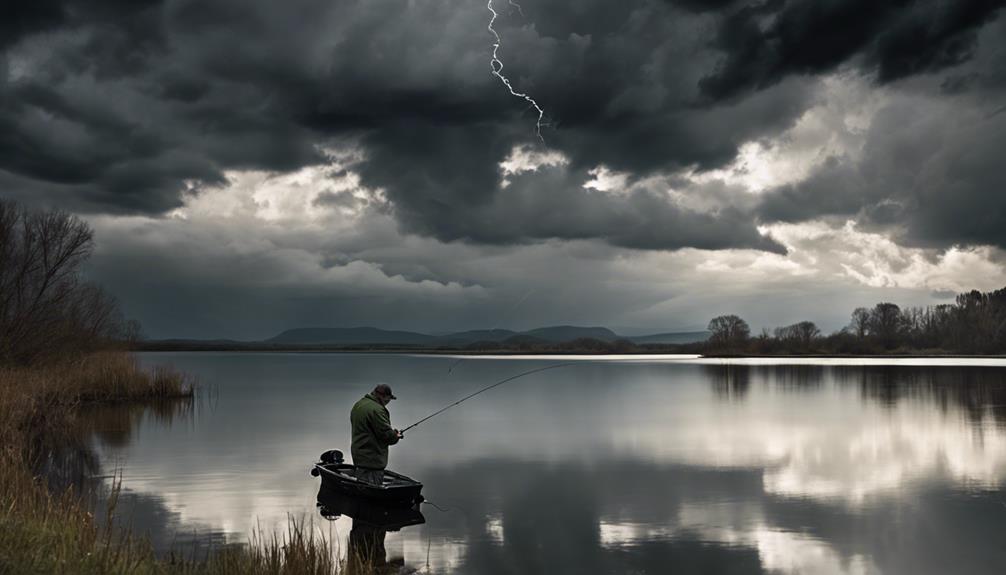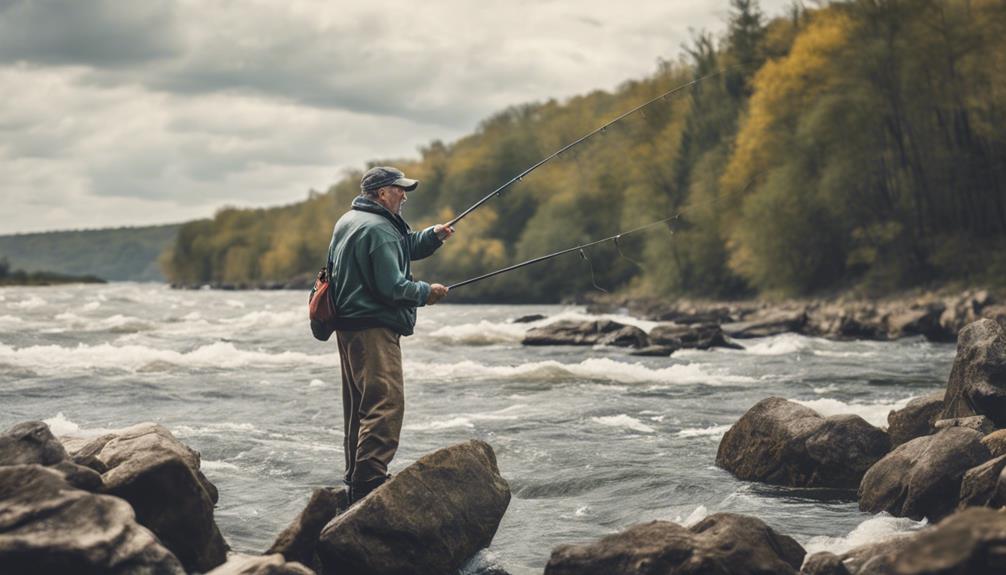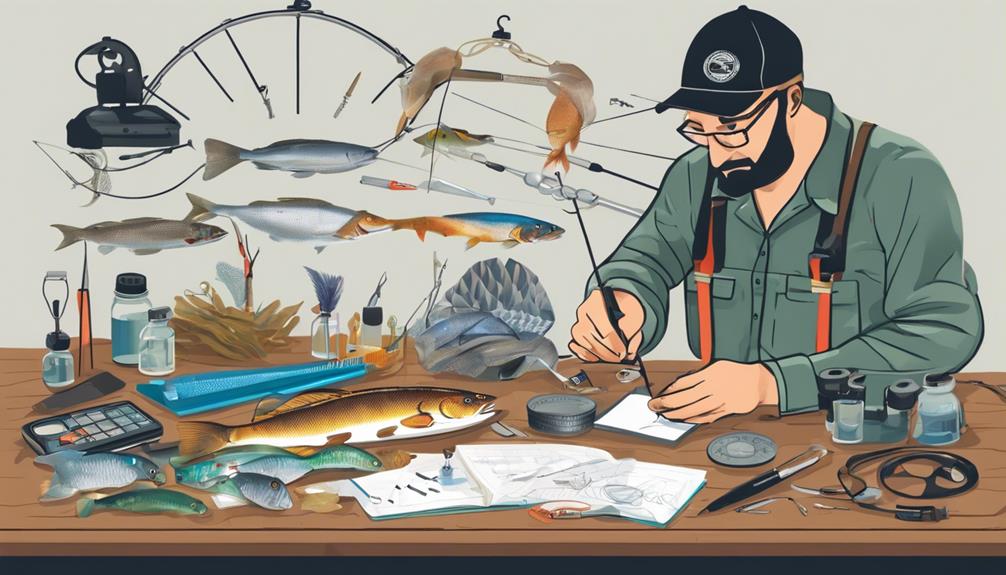When it comes to competitive angling, honing your tactics is like sharpening a blade before battle. Each move you make on the water can mean the difference between a successful catch and going home empty-handed.
From mastering the art of spotting elusive fish to leveraging weather patterns in your favor, these top 12 winning tactics will give you an edge over the competition.
So, are you ready to elevate your angling game and reel in those trophy fish?
Mastering the Art of Spotting
To become a skilled angler, you must learn the art of spotting fish in their natural habitat. Spotting techniques are crucial in competitive angling as they can make the difference between a successful catch and a missed opportunity. Visual cues play a significant role in identifying fish underwater. Look for movements such as sudden flashes of light or shadows, disturbances in the water, or subtle ripples that could indicate the presence of fish.
Camouflage is another essential aspect to consider. Just as anglers wear clothing that blends into their surroundings, fish also use camouflage to hide from predators or prey. Understanding how fish blend in with their environment can help you spot them more effectively. Keep an eye out for any patterns or colors that seem out of place in the water, as these could be signs of fish waiting to be caught.
Practice your spotting techniques regularly to improve your skills. Whether you're observing from the shore, a boat, or a kayak, take the time to scan the water carefully. Pay attention to details and train your eyes to quickly pick up on visual cues that indicate the presence of fish. By mastering the art of spotting, you'll be one step closer to becoming a successful angler in competitive fishing tournaments.
Precision in Bait Selection
For successful competitive angling, selecting the right bait with precision is key to enticing fish effectively. When it comes to bait presentation, understanding the behavior of the fish you're targeting is crucial. Different species have specific feeding habits, so tailoring your bait selection to mimic their natural prey increases your chances of a successful catch. Research the waters you'll be fishing in and consider factors such as water clarity, temperature, and the time of day to make informed decisions on lure selection.
When it comes to bait presentation, be mindful of how you present your lure to the fish. Pay attention to the speed and depth at which you're retrieving your bait, as well as the movement patterns you employ. Experiment with different retrieval techniques to see what elicits the best response from the fish. Remember, sometimes a subtle twitch or pause can make all the difference in getting a bite.
In competitive angling, precision in bait selection can be the difference between landing a trophy fish and going home empty-handed. By mastering the art of bait presentation and fine-tuning your lure selection, you can significantly improve your chances of success on the water. So, next time you hit the water, pay attention to the details, and watch as your precision in bait selection pays off with a bountiful catch.
Utilizing Advanced Casting Techniques
Mastering advanced casting techniques is essential for improving your angling skills and maximizing your chances of a successful catch. When it comes to competitive angling, two key techniques stand out: distance casting and accuracy casting.
Distance casting is crucial for reaching those elusive fish that tend to stay further away from the shore. To achieve greater distance in your casts, focus on your casting technique. Utilize the power of your entire body, not just your arms, to generate more force. Practice loading the rod correctly and releasing at the optimal moment to propel your bait or lure as far as possible.
On the other hand, accuracy casting is paramount for placing your bait precisely where the fish are lurking. Work on your aim and precision by practicing different casting angles and adjusting your strength accordingly. Take note of environmental factors such as wind direction and speed, which can affect your casting accuracy.
Strategic Positioning on the Water
When positioning yourself on the water strategically for competitive angling, consider factors such as current flow and underwater structures to increase your chances of a successful catch. Understanding the tide timing can be crucial; certain fish species are more active during specific tidal phases. By aligning your fishing times with the optimal tide, you can significantly improve your chances of hooking the targeted fish. Additionally, pay attention to the boat control. Maintaining control over your vessel is essential for staying in the desired fishing spot and adjusting your position as needed.
To maximize your effectiveness, study the water body before your angling session. Look for areas where the current flow is strong, as these are often hotspots for fish activity. Position yourself upstream of these areas, allowing your bait or lure to naturally drift towards the fish. If there are underwater structures like rocks, reefs, or vegetation, position your boat strategically to cast near these spots without getting tangled.
Proper boat control isn't just about staying in one place; it also involves maneuvering to follow the fish if they change their position due to environmental factors. By mastering the art of strategic positioning on the water, you can adapt to different conditions and increase your chances of a successful catch.
Perfecting the Hook Set
To improve your hook set technique in competitive angling, focus on precision and timing when engaging with the fish. Utilizing timing techniques and setting secrets can significantly increase your chances of a successful hook set. When you feel a bite, resist the urge to immediately jerk the rod. Instead, wait for a split second to ensure the fish has taken the bait properly before setting the hook. This slight delay can make all the difference in securing your catch.
Hooking hacks can also play a crucial role in perfecting your hook set. Ensure your hook is sharp and in good condition before casting. A dull hook can result in missed opportunities as it may not penetrate the fish's mouth effectively. Additionally, consider using circle hooks, which are designed to hook the fish in the corner of the mouth, increasing the likelihood of a secure hook set.
Once you've set the hook, remember the reeling rules. Maintain steady pressure on the fish while reeling it in, keeping the line taut to prevent the fish from shaking the hook. Avoid giving the fish too much slack, as it could use this opportunity to free itself. By following these techniques and guidelines, you can enhance your hook set proficiency and improve your overall success in competitive angling.
Effective Use of Live Bait
Improve your competitive angling success by harnessing the power of live bait effectively. When it comes to using live bait in your fishing endeavors, there are several key points to keep in mind that can help you maximize your chances of landing that prize-winning catch.
- Live Bait Advantages: Live bait can be incredibly enticing to fish due to its natural movement and scent, often resulting in more bites compared to artificial lures.
- Ethical Concerns: Some anglers have ethical concerns about using live bait, as it involves hooking a live animal. However, when done responsibly and with proper care for the bait, it can be a humane and effective method of fishing.
- Live Bait Alternatives: For those who prefer not to use live bait, there are alternatives available such as artificial lures. These lures come in various shapes, sizes, and colors to mimic different types of baitfish or prey, providing anglers with a wide range of options.
- Artificial Lures: Artificial lures can be beneficial in certain situations, such as when fishing in areas where live bait is prohibited or when targeting specific species that may not respond well to live bait.
- Experimentation: To truly master the art of using live bait effectively, don't be afraid to experiment with different types of bait, presentation styles, and fishing techniques to see what works best in different fishing conditions.
Understanding Fish Behavior
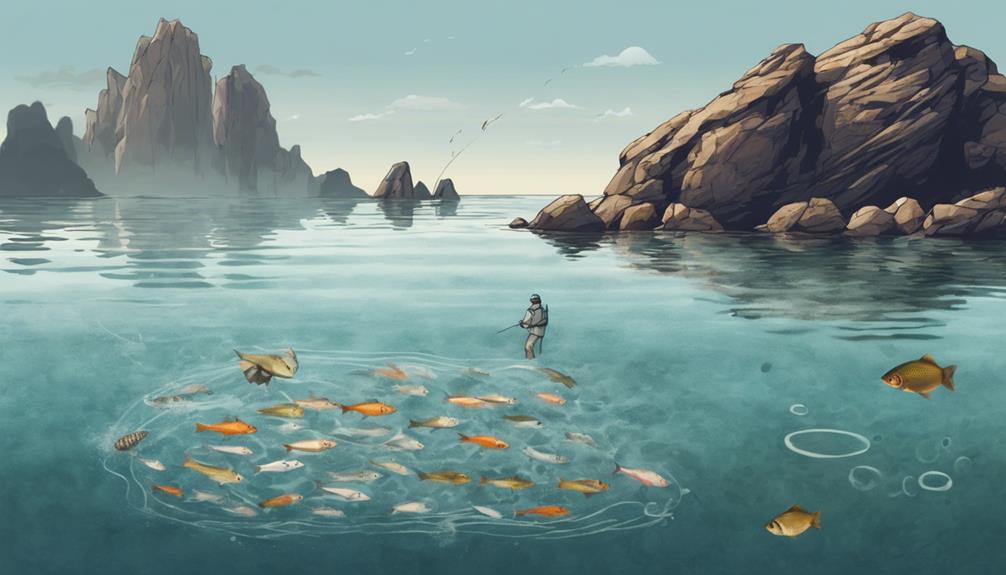
For successful angling, understanding fish behavior is key in predicting their movements and increasing your chances of a fruitful catch. Fish exhibit distinct feeding patterns influenced by various factors such as time of day, water temperature, and available food sources. By observing these patterns, you can determine the best times to fish and the most effective bait to use. Additionally, knowing the habitat preferences of different fish species is crucial. Some fish prefer deep, cool waters with plenty of cover, while others thrive in shallow, warmer areas with sandy bottoms. Understanding these preferences helps you target specific species more effectively.
Predator-prey dynamics play a significant role in fish behavior. Predators tend to follow their prey, so if you can identify where prey fish are congregating, you're likely to find predatory fish nearby. This knowledge can guide your fishing strategy, leading to more successful catches. Furthermore, fish exhibit seasonal movements in response to changing environmental conditions. During spawning seasons, for example, fish may migrate to specific areas to reproduce, presenting unique angling opportunities.
Leveraging Weather Patterns
Observing weather patterns can significantly enhance your angling success by guiding your tactics and optimizing your fishing conditions. Weather prediction plays a crucial role in determining the best times to fish, as certain weather conditions can either attract or deter fish. Understanding how to leverage weather patterns can give you a competitive edge in your angling pursuits.
- Weather Prediction: Stay updated on weather forecasts to anticipate changes that could impact fish behavior and feeding patterns.
- Wind Direction: Pay attention to wind direction as it can affect water currents and the distribution of baitfish, guiding your angling strategy.
- Fishing Success: Utilize weather patterns to your advantage by adjusting your fishing techniques based on the predicted weather conditions.
- Angling Strategy: Tailor your approach by considering how weather elements like temperature, barometric pressure, and precipitation can influence fish activity.
- Optimizing Conditions: Choose the right fishing spots and times by aligning them with favorable weather conditions to maximize your chances of success.
Frequently Asked Questions
How Can I Improve My Physical Fitness to Enhance My Angling Skills?
To improve your physical fitness for angling, focus on strength training and cardio exercises. Incorporate routines that target your core, arms, and legs to enhance technique and endurance.
Stay motivated by setting specific goals and tracking your progress. Mental focus is key, so practice mindfulness and visualization techniques to stay sharp on the water.
What Are Some Common Mistakes Anglers Make That Hinder Their Success in Competitive Fishing?
When it comes to competitive fishing, anglers often stumble due to poor equipment selection and improper technique. Another common mistake is lacking efficient time management and strategic planning.
Make sure you choose the right gear and master your angling skills. Prioritize how you use your time on the water and have a solid plan in place to increase your chances of success in the competitive fishing arena.
How Important Is It to Maintain a Positive Mindset During a Fishing Competition?
Maintaining a positive mindset during a fishing competition is crucial. Your mental toughness and focus can make all the difference in your performance.
A positive attitude and resilience will help you navigate the challenges and setbacks that may come your way. By staying focused on your goals and keeping a can-do attitude, you'll be better equipped to tackle the competition with confidence and determination.
What Role Does Patience Play in Competitive Angling, and How Can It Be Cultivated?
To excel in competitive angling, patience is key. Developing patience requires mental toughness. Stay focused during slow bites, and resist the urge to rush.
Embrace the waiting game as part of the challenge. Cultivate patience by staying calm, practicing mindfulness, and appreciating the process. Remember, in the world of competitive angling, patience isn't just a virtue but a winning strategy.
Are There Any Specific Regulations or Rules That Competitive Anglers Need to Be Aware of Before Participating in Tournaments?
Before joining tournaments, it's crucial to know fishing regulations and tournament rules. Understanding these guidelines ensures fair play and avoids penalties. Be aware of catch limits, size restrictions, and any specific rules for the tournament.
Additionally, always uphold angler etiquette and exhibit sportsmanship conduct. Respecting fellow competitors, following rules, and showing good sportsmanship are key to a successful and enjoyable competition.
Conclusion
You now possess the top 12 winning tactics for competitive angling. By mastering the art of spotting, choosing the right bait, and utilizing advanced casting techniques, you're well on your way to becoming a successful angler.
Remember to strategically position yourself on the water, perfect your hook set, and leverage weather patterns to increase your chances of catching more fish.
Keep practicing these tactics and watch your success in competitive angling soar!
